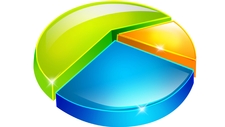Tables and Graphs

TEKS Objective
Construct appropriate simple graphs, tables, maps, and charts using technology, including computers, to organize, examine, and evaluate information.
Essential Understanding
The student uses scientific methods during laboratory and outdoor investigations.
Science Background
Using Graphs and Visual Data: Visionlearning (website) - Detailed information about the use and importance of visual representations (i.e., graphs and figures) for data analysis and interpretation. Includes references for further reading and additional learning modules.
Signature Lesson
Track the Weather with Weather Charts: Education.com (website) - Students conduct a three-part study to track the microclimate in their backyards, collecting data and creating representative charts and graphs on temperature, rainfall, and observed weather. By organizing, examining and evaluating the data, students will learn about local temperature trends and rainfall frequency.
Track the Weather with Weather Charts
By Erica Loop, Education.com
- Supporting Lessons
- Extensions
- Assessment Ideas
- Literature Connections
- Related
TEKS - Additional Resources
Supporting Lessons
Creating a Bar Graph: My NASA Data/NASA (website) - Simple lesson that uses authentic NASA data to teach students basic bar graph construction.
Elaboration Lessons and Extensions
How to Make a Graph and Chart Made Easy: Easy-Science-Fair-Projects.net (website) - Step-by-step explanation of how to organize information using graphs and charts.
How to Make a Graph and Chart Made Easy
Easy-Science-Fair-Projects.net
Impact Craters: NASA (PDF) - Impact craters are formed when impactors, such as meteorites, smash into the moon’s surface. In this activity, students use “impactors” of different masses (marbles, ball bearings, etc.) to study the relationship of an impactor’s mass to crater size. Students construct graphs, tables and charts to represent and evaluate the data collected.
Assessment Ideas
Science Skill - Using Charts and Graphs: Teacher Vision (PDF) - Students collect data on how much time they spend indoors and outdoors, and use charts and graphs to interpret and represent their findings.
Science Skill - Using Charts and Graphs
Teacher Vision, www.teachervision.fen.com
Literature Connections
Great Tables, Graphs, Charts, Diagrams & Timelines You Can Make. Zike, Dinah (ISBN-13: 978-1882796144)
Beginning Charts, Graphs & Diagrams. Carratello, Patty (ISBN-13: 978-1557341686)
Additional Resources
Create a Graph: Kids’Zone (website) - Students learn how to communicate information visually by creating graphs and charts.
Create a Graph
Kids’Zone, National Center for Education Statistics, nces.ed.gov
Representing Data, Introduction: KS3 Bitesize/BBC (website) - Links to information on creating and understanding different types of graphs or charts used to organize and represent scientific data: bar charts, line graphs, pictograms, pie charts, frequency diagrams and scatter diagrams.
Representing Data, Introduction
KS3 Bitesize, BBC, www.bbc.co.uk
TEKS Navigation
Grade 5
Need Assistance?
If you need help or have a question please use the links below to help resolve your problem.

Comments